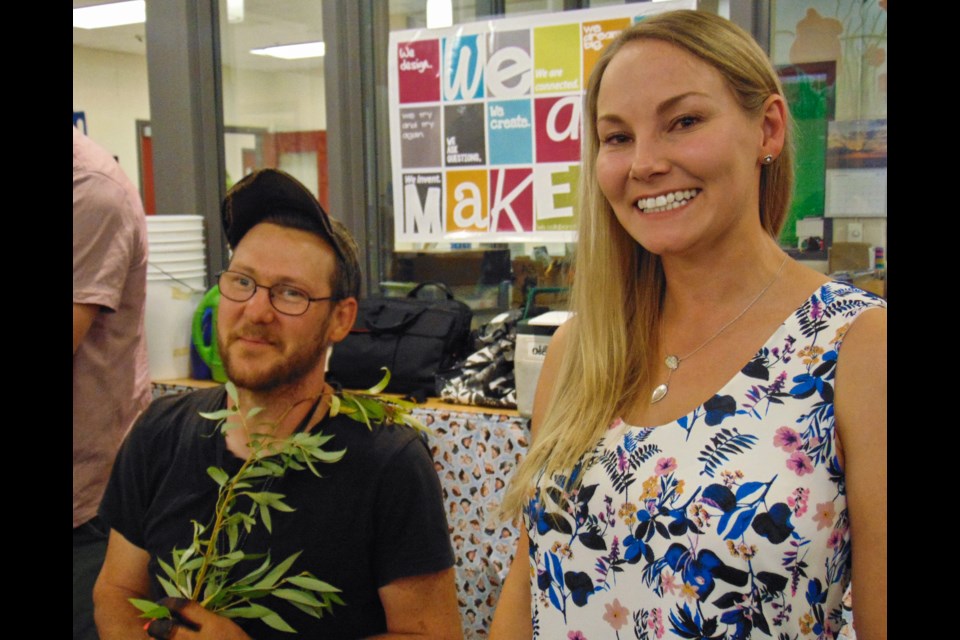Who would have known there are so many different types of willows.
This was the general consensus at the Nature Guelph Wildflower Series Annual Identification Workshop which featured the moisture-loving plants.
“There is lots of skepticism with willows but there are few key features you need to know,” said Jennifer McPhee, a botanist who presented an overview of the willows of Ontario and tips for identifying leaf characteristics.
“It is the leaves that help distinguish between species,” McPhee said.
“Are the leaves whitened underneath, what is the shape, does it have hairs and teeth on the margins and are the veins impressed? Where is it growing? And does it flower before the leaves come out?”
The event held recently at the John McCrae Public School library is an annual identification workshop and brought out an eager group, ready to key out herbarium and fresh samples with lens and tree and shrub field guides in hand.
“I’ve been doing this for over 10 years,” McPhee said. “But within the last few years, I picked a few plants but willows, this has been my latest endeavor.”
“I started with the key features and writing everything down about the willow. I found the shrub willows easier than the tree willows, so I thought it best to start with those.”
McPhee says that the terminology can be tricky too at times, but not impossible.
Originally from Nova Scotia, McPhee, a terrestrial ecologist, completed her master’s degree in botany at Western University.
“I was excited to have Jennifer call and say that she wanted come and talk to us,” said Judy Brisson, vice-president of Nature Guelph and coordinator of the Nature Guelph Wildflower Society.
Dedicated to the use and protection of native plants in parks, gardens and other spaces, members of the group range from hobby gardeners to graduate students in botany and ecology to professional landscape architects.
And some, are just simply interested.
For Byron Murray, member of the Nature Guelph/Nature Guelph Wildflower Society, it’s about coming together to learn.
“I just want to learn more about our land-base,” Murray said.
And at this year’s workshop, it was all about willows.
There are about 400 species of willows which are of the Salix genus.
Willow deciduous trees and shrubs are found primarily on moist soils in cold and temperate regions in the Northern Hemisphere. Most species are known as willow, but some narrow-leaved shrub species are called osier, and broader-leaved species are referred to as sallow.
Some willows, particularly arctic and alpine species, are low-growing or creeping shrubs. The dwarf willow for example, rarely exceeds 6 cm in height, though it spreads widely across the ground.
Three of the largest willows are black (S. nigra), crack, or brittle (S. fragilis), and white (S. alba), all reaching 20 metres (65 feet) or more. All are common in lowland situations.
Willows have simple leaves, male and female on separate trees and the seeds have long, silky hairs.
“The heart leaved willow is found in Northern Ontario mostly. The leaves are green beneath and it is a shrubby species, so it is found in marshy areas,” McPhee says.
“The sandbar willow is usually found on the water’s edge usually where sandbars grow. The key feature is the toothing on the edge of the leaves. They are far apart. It is pretty common and it’s our only colonial willow.”
The purple-osier willow is easier to find because of its colour and it’s often found in urban areas.
“Like many other willows, it just breaks off and starts growing,” McPhee said.
“The peach-leaved willow is easy to pick out from afar because the leaves dangle and it is one of our most common native trees and the Golden Weeping Willow is probably our most common willow.”
McPhee says it’s all about the little tips when looking.
“Most of the time, you just need to know what combinations to look for,” she says.
“I started this later in life. I learned at reclamation sites and then from there, that’s how it all began. Once I started, I couldn’t stop.”
What continues to bring this group of dedicated nature enthusiasts together is a desire to develop and promote a better understanding of and appreciation for Canada’s native flora.
“We want to promote the natural world,” Brisson said.
“We encourage people to be aware of our native plants. That’s why we hold this series every year.”
Nature Guelph was founded in 1966.
It is an active club for nature lovers in the Guelph area which holds monthly meetings with guest speakers, regular outdoor events and field trips within Guelph and beyond.
Apart from the Wildflower Society, there is also a Young Naturalists program for kids 6-10 years and a Naturalists in Training program for kids 11-16 years.
Membership is open to nature lovers of all ages and backgrounds. There’s always room for new members, volunteers and visitors are always welcome.
For a list of upcoming events and to become a member, visit http://www.natureguelph.ca/
“Our native plants are so important to our ecosystems. They are the foundation for the food systems and it’s these native plants that feed everything else,” Brisson said.
“Nature Guelph connects people with nature, celebrates it and protects it.”



